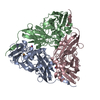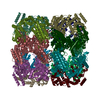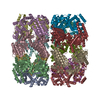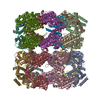+Search query
-Structure paper
| Title | Bis-sulfonamido-2-phenylbenzoxazoles Validate the GroES/EL Chaperone System as a Viable Antibiotic Target. |
|---|---|
| Journal, issue, pages | J Am Chem Soc, Vol. 146, Issue 30, Page 20845-20856, Year 2024 |
| Publish date | Jul 31, 2024 |
 Authors Authors | Jack Godek / Jared Sivinski / Edmond R Watson / Felicidad Lebario / Wenli Xu / Mckayla Stevens / Christopher J Zerio / Andrew J Ambrose / Xiaoyi Zhu / Carlee A Trindl / Donna D Zhang / Steven M Johnson / Gabriel C Lander / Eli Chapman /  |
| PubMed Abstract | We recently reported on small-molecule inhibitors of the GroES/GroEL chaperone system as potential antibiotics against and the ESKAPE pathogens but were unable to establish GroES/GroEL as the ...We recently reported on small-molecule inhibitors of the GroES/GroEL chaperone system as potential antibiotics against and the ESKAPE pathogens but were unable to establish GroES/GroEL as the cellular target, leading to cell death. In this study, using two of our most potent -sulfonamido-2-phenylbenzoxazoles (PBZs), we established the binding site of the PBZ molecules using cryo-EM and found that GroEL was the cellular target responsible for the mode of action. Cryo-EM revealed that PBZ1587 binds at the GroEL ring-ring interface (RRI). A cellular reporter assay confirmed that PBZ1587 engaged GroEL in cells, but cellular rescue experiments showed potential off-target effects. This prompted us to explore a closely related analogue, PBZ1038, which is also bound to the RRI. Biochemical characterization showed potent inhibition of Gram-negative chaperonins but much lower potency of chaperonin from a Gram-positive organism, . A cellular reporter assay showed that PBZ1038 also engaged GroEL in cells and that the cytotoxic phenotype could be rescued by a chromosomal copy of GroEL/GroES or by expressing a recalcitrant RRI mutant. These data argue that PBZ1038's antimicrobial action is exerted through inhibition of GroES/GroEL, validating this chaperone system as an antibiotic target. |
 External links External links |  J Am Chem Soc / J Am Chem Soc /  PubMed:39041457 PubMed:39041457 |
| Methods | EM (single particle) |
| Resolution | 3.26 - 3.97 Å |
| Structure data | EMDB-45078, PDB-9c0b: EMDB-45079, PDB-9c0c: EMDB-45080, PDB-9c0d:  EMDB-45098: E.coli GroEL + PBZ1587 inhibitor C1 reconstruction |
| Chemicals |  PDB-1as6: |
| Source |
|
 Keywords Keywords | CHAPERONE / GroEL / Inhibitor / ANTIBIOTIC |
 Movie
Movie Controller
Controller Structure viewers
Structure viewers About Yorodumi Papers
About Yorodumi Papers










